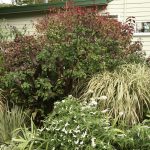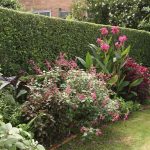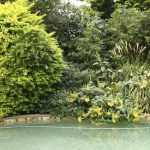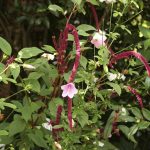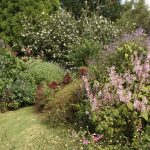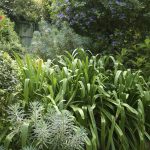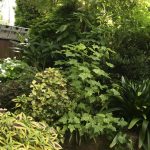Anyone who surfs the web looking for plant info will have come across Deirdre Mowat’s fabulous igarden.com.au site. Packed with information about the plants she grows in her Sydney garden, Deirdre brings decades of plant knowledge, meticulous botanical research and hands-on ‘I really do my own gardening’ experience to her plant profiles.
So what’s her own garden really like? I was recently privileged to get an invite (with local designer Peter Nixon, hort journo colleague Paul Urquhart and plantsman Ian Percy) to suss out the real world of iGarden, to dig the dirt, smell the roses and see whether the garden of iGarden lives up to those luscious website photos.
And, oh my word, does it ever. iGarden manages to combine being a plantaholic’s nirvana with the utmost practicality. Deirdre’s experiments over the years means that she knows what performs through both Sydney’s summer humidity and mild winters. You’d think that finding good performing plants for Sydney would be a walk in the park, with our relatively good coastal rainfall and only occasional heavy frosts, but it’s surprisingly not that easy. Many new plant releases are bred in Victoria, and so often don’t cope with our higher summer rainfall and humidity, or suffer from a lack of proper winter chilling and dormancy. Others come to us from the subtropical north coast, shining through the summer heat but then looking horribly dull and lifeless during our colder, and longer, winter.
It’s taken years of Deirdre’s patient experiments to cherry-pick the best of both worlds and combine them into a stunning array of plant pictures. She’s very self-effacing about what she does, even saying before we came “please don’t expect a show garden!” But often the best gardeners are. Most people can grow at least some plants in their garden, and quite a lot of gardeners can even do that very well. But the best gardens are all about how you combine those plants, finding both situational compatibility like sun/shade, drainage requirements and water needs, so that each plant grows to its peak, as well as putting together shapes, tones, colours and textures – what I call plant pictures. Some gardeners hit on it by happy accident every now and then, delightedly finding that one part of their garden just ‘works’. Why it does is often elusive, so it’s hard to repeat.
A small group of good gardeners also have an innate artist’s eye, so with only a bit of trial and error, their plant pictures are consistently high quality through most of the year. I see a lot of gardens, as a selector for Open Gardens Australia, as a professional garden writer and as a total sticky beak who’s habitually craning a look over fences, through gates and wangling invites whenever I hear of something worth seeing. The really good gardens are the ones where the gardener sees beyond the beauty of an individual rose or favourite plant and concentrates on the combos. So I won’t describe Deirdre’s garden to you – you can look at the slideshow to see exactly what I mean (click on the images for larger versions), and then visit igarden.com.au to learn about her plants.
And if you are a fan of the plant family Acanthaceae, which are terrific plants for Sydney gardens, including Acanthus, Dicliptera, Eranthemum, Justicia, Megaskepasma, Ruellia, Strobilanthes and Thunbergia you must get a copy of Deirdre Mowat’s self-published booklet ‘Meet the family Acanthaceae‘, available by mail order from iGarden. There is an earlier publication ‘Growing Salvias in Sydney Gardens‘ which you also shouldn’t be without.
#gallery-1 {margin: auto;}#gallery-1 .gallery-item {float: left;margin-top: 10px;text-align: center;width: 33%;}#gallery-1 img {border: 2px solid #cfcfcf;}#gallery-1 .gallery-caption {margin-left: 0;}/* see gallery_shortcode() in wp-includes/media.php */